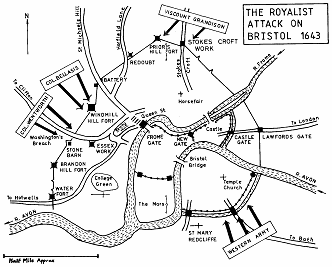September 2010
The Society kicked off its autumn lecture series on 14th September, when Dr Jonathan Harlow of UWE spoke about Bristol’s role in the English Civil War.
In the 1630s, with civil war looming, the city of Bristol was governed by a Common Council led by the mayor and aldermen. The autocratic rule of Charles I seems to have caused less resentment in Bristol than in many areas of the country, and the controversial religious reforms of the King and Archbishop Laud were relatively undivisive in the city, where a tolerant approach to differing religious traditions seems to have prevailed.
At the outbreak of the Civil War the people of Bristol began to align themselves with King or Parliament. The Common Council, however, strove to suppress the divisions, determined to keep Bristol out of the war, and the war out of Bristol. Raising the wrong side’s standard would be ruinous for the city and the Council therefore attempted to maintain an official neutrality, declaring that they were “in love and amity one with another” – whilst at the same time attending to more practical matters like repairing the city gates and strengthening its defences.
In December 1642, however, Parliamentary forces moved on Bristol. The Council seems to have got cold feet about utilising its new defences, and the city was taken. The Council was removed from power and the city placed under the military governorship of Nathaniel Fiennes.

(c) Patrick McGrath
In July 1643, Royalists under the command of Price Rupert of the Rhine besieged and took the city. Bristol became an important Royalist stronghold and the principal supplier of munitions to the Royalist army. As far as the citizens were concerned, however, the city was under military occupation. More than 1000 troops were billeted with the townspeople, and the soldiers seem to have conducted themselves in a particularly riotous fashion – perhaps to emphasise their difference from the puritanical Parliamentarians. The citizens were required to foot the costs of the garrison through weekly levies, while the goods they produced were paid for by way of paper promissory notes which, perhaps unsurprisingly, were dishonoured by the victorious Parliamentary forces after the war. To cap it all, Bristol also had to endure its last major bout of plague, which caused the deaths of perhaps 3000 of the 13000 inhabitants.

(c) Patrick McGrath
By 1645 the tide of the war had turned and the city was besieged by Parliament’s New Model Army. The fighting was fierce, but the Parliamentarians eventually succeeded in retaking the city. Though still under military occupation, the costs which the citizens had to bear were now lower and the Parliamentarian troops better disciplined. What is more, the Parliamentary forces’ promissory notes were actually honoured! A few months later, the war was over and the Common Council was effectively restored to power.
In the decade following the war, the Council was keen to reassert its independence. For almost two years it ignored orders to sequester (i.e. confiscate) the property of Royalists, and the Council showed no real interest in implementing Parliament’s reforms, such as the establishment of a Presbyterian Church structure. Its recalcitrance meant that by 1648 Bristol had almost developed a reputation as a Royalist city.
What is remarkable about Bristol is the degree to which the Common Council remained united during the Civil War and its aftermath. Whilst its individual members undoubtedly subscribed to the ideology of one side or the other, their principal concern was to protect the independence and authority of the Council as a whole, and in the face of war they stood, by and large, united. Perhaps ironically, it took the Restoration of the Monarchy in 1660 to expose the divisions within the Common Council.
The next meeting of the Thornbury Local History and Archaeology Society will be on 12th October 2010, when Peter Lamb will speak about Electrical Appliances of a Bygone Era.
The Thornbury Local History and Archaeology Society always welcomes new and occasional members. Details of our programme can be found on this website, the library or the Town Hall. Our meetings are on the second Tuesday of the month, held at St Mary's Church Hall beginning at 7.30pm. Visitors are always welcome at the society for the small charge of £3.50